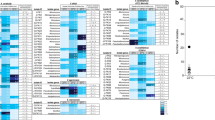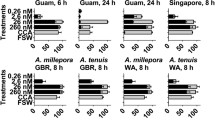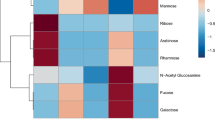Abstract
Corals harbor symbiotic dinoflagellates, Symbiodinium spp., acquired from surrounding environments. Because Symbiodinium are present at low densities in the water column, corals may attract these symbionts using chemotactic compounds. To examine whether corals contain chemotactic compounds, we established an assay to measure the chemotactic activity for Symbiodinium using an extract of the coral Acropora tenuis, a major reef-building coral in Japan. Our assay revealed that Symbiodinium strain NBRC102920 (clade A), which is taken up by juvenile A. tenuis polyps, is attracted to crude A. tenuis extracts. We found that the chemotactic compounds are water-soluble, heat-labile macromolecules and that the chemotactic activity was inhibited by N-acetyl-d-glucosamine (GlcNAc). We separated the GlcNAc-binding fraction (Fr-ActL) and identified it as the most plausible candidate for the chemoattractant, since the chemotactic activity of the crude A. tenuis extract appeared to be mainly attributable to the activity of Fr-ActL and was also inhibited by the addition of GlcNAc. These results indicate that chemoattraction is mediated via the binding of Symbiodinium to Fr-ActL.







Similar content being viewed by others
References
Hoegh-Guldberg O (1999) Climate change, coral bleaching and the future of the world’s coral reefs. Mar Freshw Res 50:839–866
Weis VM (2008) Cellular mechanisms of cnidarian bleaching: stress causes the collapse of symbiosis. J Exp Biol 211:3059–3066
Baird AH, Guest JR, Willis BL (2009) Systematic and biogeographical patterns in the reproductive biology of scleractinian corals. Annu Rev Ecol Evol Syst 40:551–571
Yamashita H, Suzuki G, Hayashibara T, Koike K (2013) Acropora recruits harbor “rare” Symbiodinium in the environmental pool. Coral Reefs 32:355–366
Fitt WK, Chang SS, Trench RK (1981) Motility patterns of different strains of the symbiotic dinoflagellate Symbiodinium (=Gymnodinium) microadriaticum (Freudenthal) in culture. Bull Mar Sci 31:436–443
Fitt WK (1984) The role of chemosensory behavior of Symbiodinium microadriaticum, intermediate hosts, and host behavior in the infection of coelenterates and molluscs with zooxanthellae. Mar Biol 81:9–17
Pasternak Z, Bachar A, Abelson A, Achituv Y (2004) Initiation of symbiosis between the soft coral Heteroxenia fuscescens and its zooxanthellae. Mar Ecol Prog Ser 279:113–116
Yamashita H, Suzuki G, Kai S, Hayashibara T, Koike K (2014) Establishment of coral–algal symbiosis requires attraction and selection. PLoS One 9:e97003
Fitt WK (1985) Chemosensory responses of the symbiotic dinoflagellate Symbiodinium microadriaticum (Dinophyceae). J Phycol 21:62–67
Sjoblad RD, Chet I, Mitchell R (1978) Quantitative assay for algal chemotaxis. Appl Environ Microbiol 36:847–850
Nishikawa A, Katoh M, Sakai K (2003) Larval settlement rates and gene flow of broadcast-spawning (Acropora tenuis) and planula-brooding (Stylophora pistillata) corals. Mar Ecol Prog Ser 256:87–97
Iwao K, Fujisawa T, Hatta M (2002) A cnidarian neuropeptide of the GLW amide family induces metamorphosis of reef-building corals in the genus Acropora. Coral Reefs 21:127–129
Yuyama I, Hayakawa H, Endo H, Iwao K, Takeyama H, Maruyama T, Watanabe T (2005) Identification of symbiotically expressed coral mRNAs using a model infection system. Biochem Biophys Res Commun 336:793–798
Kuniya N, Jimbo M, Tanimoto F, Yamashita H, Koike K, Harii S, Nakano N, Iwao K, Yasumoto K, Watabe S (2015) Possible involvement of tachylectin-2-like lectin from Acropora tenuis in the process of Symbiodinium acquisition. Fish Sci 81:473–483
Lee SY, Jeong HJ, Kang NS, Jang TY, Jang SH, Lajeunesse TC (2015) Symbiodinium tridacnidorum sp. nov., a dinoflagellate common to Indo-Pacific giant clams, and a revised morphological description of Symbiodinium microadriaticum Freudenthal, emended Trench & Blaank. Eur J Phycol 50:155–172
Jimbo M, Yoshida T, Koike K, Koike K, Sakai R, Muramoto K, Kamiya H (2000) The d-galactose-binding lectin of the octocoral Sinularia lochmodes: characterization and possible relationship to the symbiotic dinoflagellates. Comp Biochem Physiol B 125:227–236
Laemmli UK (1970) Cleavage of structural proteins during the assembly on the head of bacteriophage T4. Nature 277:680–685
Yoshida M, Murata M, Inaba K, Morisawa M (2002) A chemoattractant for ascidian spermatozoa is a sulfated steroid. Proc Natl Acad Sci USA 99:14831–14836
Miyazaki S, Ichiba T, Reimer JD, Tanaka J (2014) Chemoattraction of the pearlfish Encheliophis vermicularis to the sea cucumber Holothuria leucospilota. Chemoecology 24:121–126
Hagedron M, Carter V, Zuchowicz N, Phillips M, Penfield C, Shamenek B, Vallen EA, Kleinhans FW, Peterson K, White M, Yancey PH (2015) Trehalose is a chemical attractant in the establishment of coral symbiosis. PLoS One 10:e0117087
Miller RL, Vogt R (1996) An N-terminal partial sequence of the 13 kDa Pycnopodia helianthoides sperm chemoattractant “startrak” possesses sperm-attracting activity. J Exp Biol 199:311–318
Lin KL, Wang JT, Fang LS (2000) Participation of glycoproteins on zooxanthellal cell walls in the establishment of a symbiotic relationship with the sea anemone, Aiptasia pulchella. Zool Stud 39:172–178
Wood-Charlson EM, Hollingsworth LL, Krupp DA, Weis VM (2006) Lectin/glycan interactions play a role in recognition in a coral/dinoflagellate symbiosis. Cell Microbiol 8:1985–1993
Kvenneforts ECE, Leggat W, Kerr CC, Ainsworth TD, Hoegh-Guldberg O, Barnes AC (2010) Analysis of evolutionarily conserved innate immune components in coral links immunity and symbiosis. Dev Comp Immunol 34:1219–1229
Acknowledgements
The authors would like to thank Dr. Hiroshi Yamashita for useful advice on the preparation of this manuscript. This work was supported by a Grant-in-Aid for Scientific Research (C) from the Ministry of Education, Culture, Sports, Science and Technology of Japan to MJ [22580228] and partially by a grant-in-aid from The Mikimoto Fund for Marine Ecology, Japan.
Author information
Authors and Affiliations
Corresponding author
Rights and permissions
About this article
Cite this article
Takeuchi, R., Jimbo, M., Tanimoto, F. et al. Establishment of a model for chemoattraction of Symbiodinium and characterization of chemotactic compounds in Acropora tenuis . Fish Sci 83, 479–487 (2017). https://doi.org/10.1007/s12562-017-1069-1
Received:
Accepted:
Published:
Issue Date:
DOI: https://doi.org/10.1007/s12562-017-1069-1




